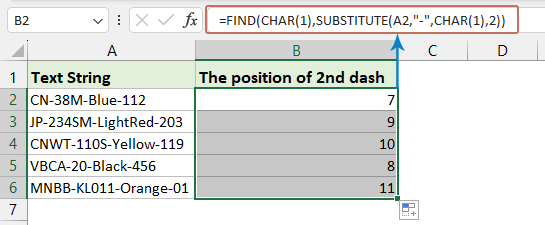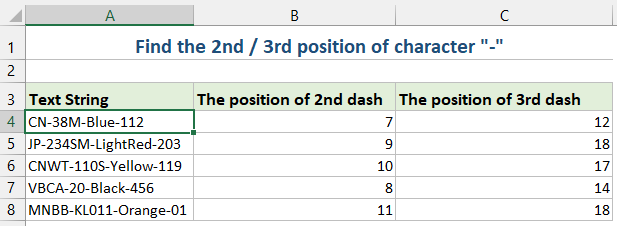在 Excel 中查找某个字符第 n 次出现的位置 – 3 种快速方法
作者:晓阳
最后修改时间:2024-04-24
在 Excel 中的文本字符串中查找特定字符的第 n 次出现在数据分析中特别有用,您可能需要根据某些分隔符或模式来解析字符串或提取信息。例如,让我们查找文本字符串中第二次或第三次出现的字符“-”。我将演示有效完成此任务的简单技术。
使用公式查找文本字符串中某个字符的第 n 次出现
您可以设计一个公式来查找某个字符的第 n 次出现。请按如下操作:
1. 将以下公式输入或复制到要获取结果的单元格中:
=FIND(CHAR(1),SUBSTITUTE(A2,"-",CHAR(1),2))备注:在上式中:
- A2:包含字符串的单元格。
- -: 您正在寻找的角色。
- 2:您要查找的第二个出现,您可以根据需要将其更改为 2...。
2、然后,向下拖动公式填充,将公式填充到其他单元格中,第2个位置的字符-立即显示出来,见截图:
公式说明:
- 替代 将第 n 次出现的字符替换为不可打印字符 (CHAR(1))。
- FIND 搜索此不可打印字符,给出第 n 次出现的位置。
使用 Kutools for Excel 查找文本字符串中字符的第 n 次出现
如果您不喜欢使用公式或 VBA,您可能会考虑一个方便的替代方案 – Kutools for Excel。在其公式组中,您会发现一个有用的实用程序 – 查找字符在字符串中第N个出现的位置 它可以快速识别并返回单元格中任何字符的第 n 个位置。
安装 Kutools for Excel 后,单击“ 库工具 > 公式助手 > 公式助手 打开 公式助手 对话框。单击要放置结果的单元格。然后,执行以下操作:
- 选择 查找 从下拉列表中选择 公式类型 部分;
- 查找字符在字符串中第N个出现的位置 in 选择一个公式 部分;
- 选择包含您使用的字符串的单元格,然后在文本框中键入指定的字符和第 n 次出现的字符 参数输入 部分;
- 最后点击 OK 按钮获取结果。

Tips: 对这个功能感兴趣,请 点击下载即可免费试用 30 天.
使用用户定义函数查找文本字符串中第 n 个出现的字符
在本节中,我们将探讨如何创建和使用 UDF 来查找 Excel 中某个字符的第 n 次出现,并提供分步指南来帮助您优化数据处理。
- 按住 ALT + F11 键,然后打开 Microsoft Visual Basic应用程序 窗口。
- 点击 插页 > 模块,然后将以下宏粘贴到“模块窗口”中。
Function FindN(sFindWhat As String, _ sInputString As String, N As Integer) As Integer 'Updateby Extendoffice Dim J As Integer Application.Volatile FindN = 0 For J = 1 To N FindN = InStr(FindN + 1, sInputString, sFindWhat) If FindN = 0 Then Exit For Next End Function - 然后,关闭 vba 窗口。返回工作表,在单元格中输入以下公式,然后向下拖动填充柄将公式填充到其他单元格,请参见屏幕截图:
=FindN("-",A2,3)
- 计算某个单词在列中出现的次数
- 如果您有一个包含一些重复值的列数据,如下面的屏幕快照所示,那么现在要做的就是计算该列中特定单词出现的次数。 现在,通过本教程,我将介绍一些技巧以在Excel中快速解决该问题。
- 将前 n 个字符或第 n 个出现的字符替换为另一个字符
- 在Excel中,我们通常使用“查找和替换”功能查找和替换字符串,但是如果您属于以下情况之一,则“查找和替换”功能将无法为您提供帮助。
- 从字符串中提取第 n 个字符
- 一般来说,您可能想要提取特定字符后的字符串,但在这种情况下,我想从字符串中提取第 n 个字符,如下图所示。
- 从字符串中提取前/后 n 个字符
- 例如,在每个单元格中都有一个包含长字符串的列表,您只想从每个字符串中提取前n个字符,就像每个字符串的前3个字符一样,现在您可以使用以下方法在Excel中解决它。
相关文章:
最佳办公生产力工具
| 🤖 | Kutools 人工智能助手:基于以下内容彻底改变数据分析: 智能执行 | 生成代码 | 创建自定义公式 | 分析数据并生成图表 | 调用 Kutools 函数... |
| 热门特色: 查找、突出显示或识别重复项 | 删除空白行 | 合并列或单元格而不丢失数据 | 不使用公式进行四舍五入 ... | |
| 超级查询: 多条件VLookup | 多值VLookup | 跨多个工作表的 VLookup | 模糊查询 .... | |
| 高级下拉列表: 快速创建下拉列表 | 依赖下拉列表 | 多选下拉列表 .... | |
| 列管理器: 添加特定数量的列 | 移动列 | 切换隐藏列的可见性状态 | 比较范围和列 ... | |
| 特色功能: 网格焦点 | 设计图 | 大方程式酒吧 | 工作簿和工作表管理器 | 资源库 (自动文本) | 日期选择器 | 合并工作表 | 加密/解密单元格 | 按列表发送电子邮件 | 超级筛选 | 特殊过滤器 (过滤粗体/斜体/删除线...)... | |
| 前 15 个工具集: 12 文本 工具 (添加文本, 删除字符,...) | 50+ 图表 类型 (甘特图,...) | 40+ 实用 公式 (根据生日计算年龄,...) | 19 插入 工具 (插入二维码, 从路径插入图片,...) | 12 转化 工具 (小写金额转大写, 货币兑换,...) | 7 合并与拆分 工具 (高级组合行, 分裂细胞,...) | ... 和更多 |
使用 Kutools for Excel 增强您的 Excel 技能,体验前所未有的效率。 Kutools for Excel 提供了 300 多种高级功能来提高生产力并节省时间。 单击此处获取您最需要的功能...

Office Tab 为 Office 带来选项卡式界面,让您的工作更加轻松
- 在Word,Excel,PowerPoint中启用选项卡式编辑和阅读,发布者,Access,Visio和Project。
- 在同一窗口的新选项卡中而不是在新窗口中打开并创建多个文档。
- 每天将您的工作效率提高50%,并减少数百次鼠标单击!

Sort comments by
#38962
This comment was minimized by the moderator on the site
0
0
#39007
This comment was minimized by the moderator on the site
Report
0
0
#35464
This comment was minimized by the moderator on the site
0
0
#35341
This comment was minimized by the moderator on the site
0
0
#26348
This comment was minimized by the moderator on the site
0
0
#38963
This comment was minimized by the moderator on the site
0
0
#26349
This comment was minimized by the moderator on the site
0
0
#24877
This comment was minimized by the moderator on the site
Report
0
0
#24880
This comment was minimized by the moderator on the site
Report
0
0
#24878
This comment was minimized by the moderator on the site
Report
0
0
#24879
This comment was minimized by the moderator on the site
Report
0
0
#24362
This comment was minimized by the moderator on the site
Report
0
0
#24363
This comment was minimized by the moderator on the site
Report
0
0
#24355
This comment was minimized by the moderator on the site
0
0
#20513
This comment was minimized by the moderator on the site
0
0
#17331
This comment was minimized by the moderator on the site
0
0
#17332
This comment was minimized by the moderator on the site
0
0
#13390
This comment was minimized by the moderator on the site
0
0
#13391
This comment was minimized by the moderator on the site
0
0
There are no comments posted here yet
